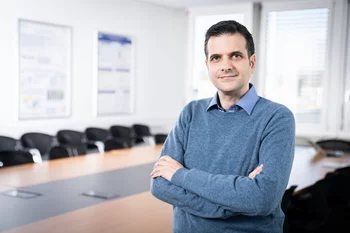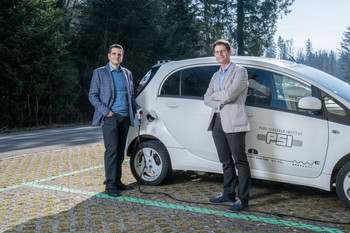Can Switzerland, as planned, cut its CO2 emissions to zero by 2050? In a study, researchers at the Paul Scherrer Institute PSI have investigated what measures would be necessary to achieve this reduction and how much it might cost per person.
(Photo: Paul Scherrer Institute/Mahir Dzambegovic)
(Photo: Paul Scherrer Institute/Mahir Dzambegovic)
In August 2019, the Swiss Federal Council decided on an ambitious target to limit climate change: From the year 2050 onward Switzerland should, on balance, discharge no further greenhouse gas emissions. With this commitment, Switzerland meets the internationally agreed goal of limiting global warming to a maximum of 1.5° C compared to the pre-industrial era.
Now a study by the Paul Scherrer Institute, conducted within the Joint Activity "Scenarios and Modelling" of the eight Swiss Competence Centres for Energy Research (SCCER), probes what options for achieving this goal exist in the energy sector.
"The goal of achieving net zero CO2 emissions by 2050 requires drastic transformations in the provision and consumption of energy in nearly all areas," concludes Tom Kober, head of the PSI Energy Economics Group and one of the study's main authors.
In their analyses, the researchers considered energy-related CO2 emissions as well as CO2 emissions from industrial processes. Today these emissions represent around 80% of the entire Swiss greenhouse gas inventory. Not included in the study's calculations are emissions from international aviation, agriculture - with the exception of emissions from fuel combustion - land use, changes in land use, and forestry, as well as waste - except for emissions from waste incineration. Also, emissions in other countries that are associated with consumption of goods in Switzerland were not a subject of the study.
Electricity from photovoltaics must at least double every decade
The central conclusions of the study are: Between now and 2050, the installed capacity of photovoltaic systems must at least double every decade. With 26 terawatt hours of production envisioned in 2050, photovoltaic systems will be the second largest generation technology group behind hydropower (approx. 38 terawatt hours in 2050). Furthermore, power plants with cogeneration of heat and power, as well as wind power plants, hydrogen fuel cells, and electricity imports, all contribute to meeting the demand for electricity. In the main scenario for achieving the net zero emissions target, overall electricity generation from power plants and storage facilities in Switzerland will increase by around one-fifth, to 83 terawatt hours in 2050. The study assumes that Swiss nuclear power plants will be decommissioned by 2045. The private car fleet would have to be largely based on electric motors by 2050, meaning that by 2030 every third new car registered would have to be fully electric. In addition, the use of heat pumps in service and living areas would have to be significantly accelerated, so that by 2050 they could cover almost three-quarters of the demand for heating and hot water. At the same time, it would be necessary to achieve significant energy savings through accelerated renovation of residential buildings.
If Switzerland wants to achieve the net zero emissions target, a significant increase in electricity consumption must be expected. Thus in 2050, electricity consumption might be around 20 terawatt hours above today's level. A fundamental driver of this growth is the use of electricity to power cars, buses, and trucks, either directly in battery-electric vehicles or indirectly through hydrogen or so-called e-fuels - that is, synthetic fuels, which are produced by means of electricity from hydrogen and CO2. In the stationary sectors, the proliferation of installed heat pumps will increase consumption of electricity. If the necessary efficiency gains in heating and hot water supply are achieved, however, these could compensate for the increased electricity consumption. The study results show that stationary sectors could achieve an almost constant level of electricity consumption.
Besides electrical energy, other forms of energy will play a role. For example, long-distance and freight transport as well as energy-intensive industry offer prospects for new hydrogen applications. To produce such low or zero emission hydrogen requires a substantial amount of sustainably generated electricity would be necessary - 9 terawatt hours in 2050.
It probably won't work without CO2 capture
"If Switzerland wants to achieve the zero emissions target by 2050, then in the future CO2 emissions will have to be reduced every year by an average of one to one and a half million tonnes compared to the previous year," says Evangelos Panos, lead author of the study. "We saw changes in CO2 emissions of this magnitude between 1950 and 1980 - albeit in the opposite direction - back then they increased massively." Though it has limitations, CO2 capture was shown to be necessary to implement the emissions reduction cost-effectively. In some subsectors, it might even be possible to reach a negative balance in terms of CO2 emissions. This would be the case, for example, if biomass is used as an energy source and the CO2 produced during energy generation is not emitted, but rather is captured and stored underground. In the event that this should not be possible in Switzerland - for example due to rejection by the population or because of limited sites for CO2 storage - cross-national transport of captured CO2 and storage in other countries could offer aa alternative. In their study the researchers assume, for the year 2050, a total of almost 9 million tonnes of CO2 would be captured in Switzerland.
"More than two-thirds of the emission reductions required for the net zero emissions target can be achieved with technologies that are already commercially available or are in the demonstration phase," Panos explains. The decarbonised energy system of the future is achievable but would require carbon-free energy sources, for example appropriately generated electricity, biofuels and e-fuels, access to the corresponding transport and distribution infrastructures, and the possibility of importing clean fuels and electricity.
Costs are hard to estimate
With regard to costs, the energy system researchers are cautious. "The costs are very difficult to estimate, because an enormous number of components play a role," Kober says. In the net zero main scenario assumed in the study, the average discounted additional costs of the climate protection scenario compared to the reference scenario with moderate climate protection (40% CO2 reduction in 2050 compared to 1990) in Switzerland would amount to around 330 CHF per person per year (basis 2010) for the period up to 2050. Looking at all of the scenarios examined, one can see a range of average costs between 200 and 860 CHF2010 per person per year, which ultimately reflects different developments in energy technologies, resource availability, and market integration, in the acceptance of technologies, and in preferences regarding supply security. The trend in costs shows, above all, a long-term increase, so comparatively high costs can also be expected after 2050.
The study is based on calculations made with the Swiss TIMES Energy System Model (STEM) of PSI, which maps the entire energy system of Switzerland including the various interactions between technologies and sectors. STEM combines a long-term time horizon with high intra-year temporal resolution and calculates, for various future framework assumptions, the cost-minimal configurations of the energy system and the attainment of different energy and climate policy goals. The model was significantly further developed as part of this research project, especially with regard to the options for realising net zero CO2 emissions scenarios. The model is used to calculate scenarios, not to make predictions, but rather give insights into the diverse interactions in the energy system and thus to make a contribution to decision-making support in politics, industry, and society. Specifically, three main scenarios were examined in this study: A reference scenario, a net zero CO2 emissions reduction scenario, and a scenario that assumes the goals of the Swiss Energy Strategy 2050 without explicitly specifying a CO2 reduction target. In addition, seven different variants of the main scenarios were analysed, such as one variant with high technological innovation potential and another variant oriented towards reducing dependence on energy imports.
In addition to PSI, the following institutions are involved in the SCCER Joint Activity "Scenarios and Modelling" collaborative framework: Empa, EPFL, ETH Zurich, Lucerne University of Applied Sciences and Arts, the University of Basel, the University of Geneva, and WSL. The study was financed by Innosuisse - the Swiss Innovation Agency.
Text: Paul Scherrer Institute








